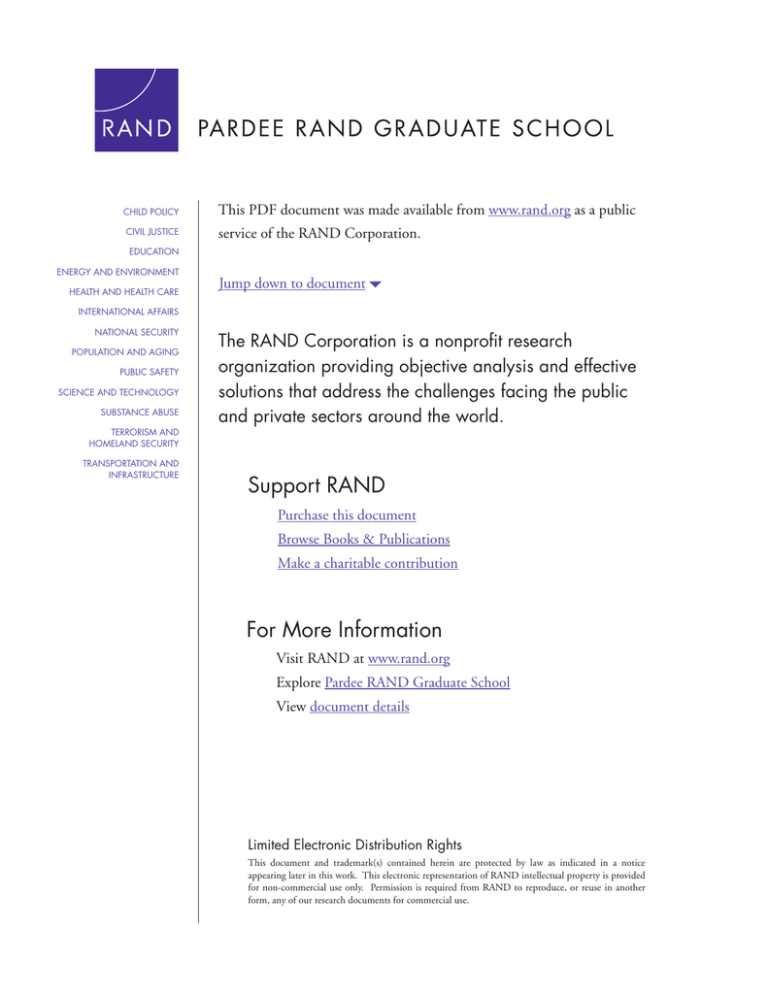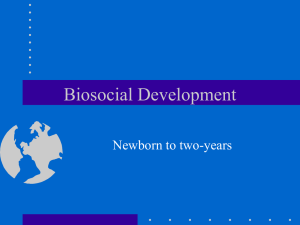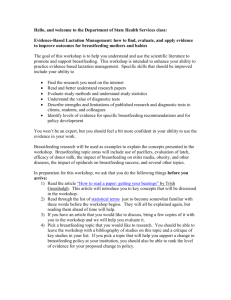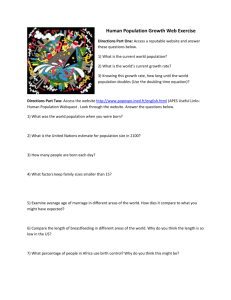
CHILD POLICY
CIVIL JUSTICE
This PDF document was made available from www.rand.org as a public
service of the RAND Corporation.
EDUCATION
ENERGY AND ENVIRONMENT
HEALTH AND HEALTH CARE
Jump down to document6
INTERNATIONAL AFFAIRS
NATIONAL SECURITY
POPULATION AND AGING
PUBLIC SAFETY
SCIENCE AND TECHNOLOGY
SUBSTANCE ABUSE
TERRORISM AND
HOMELAND SECURITY
TRANSPORTATION AND
INFRASTRUCTURE
The RAND Corporation is a nonprofit research
organization providing objective analysis and effective
solutions that address the challenges facing the public
and private sectors around the world.
Support RAND
Purchase this document
Browse Books & Publications
Make a charitable contribution
For More Information
Visit RAND at www.rand.org
Explore Pardee RAND Graduate School
View document details
Limited Electronic Distribution Rights
This document and trademark(s) contained herein are protected by law as indicated in a notice
appearing later in this work. This electronic representation of RAND intellectual property is provided
for non-commercial use only. Permission is required from RAND to reproduce, or reuse in another
form, any of our research documents for commercial use.
This product is part of the Pardee RAND Graduate School (PRGS) dissertation series.
PRGS dissertations are produced by graduate fellows of the Pardee RAND Graduate
School, the world’s leading producer of Ph.D.’s in policy analysis. The dissertation has
been supervised, reviewed, and approved by the graduate fellow’s faculty committee.
An Investigation of the
Factors Influencing
Breastfeeding Patterns
ALISON JACKNOWITZ
This document was submitted as a dissertation in May 2004 in partial
fulfillment of the requirements of the doctoral degree in policy analysis at the
Pardee RAND Graduate School. The faculty committee that supervised and
approved the dissertation consisted of Steven J. Haider (Co-Chair), M. Rebecca
Kilburn (Co-Chair), Julie DaVanzo, and Robert F. Schoeni.
The Pardee RAND Graduate School dissertation series reproduces dissertations that have
been approved by the student’s dissertation committee.
The RAND Corporation is a nonprofit research organization providing objective analysis
and effective solutions that address the challenges facing the public and private sectors
around the world. RAND’s publications do not necessarily reflect the opinions of its research
clients and sponsors.
R® is a registered trademark.
© Copyright 2004 RAND Corporation
All rights reserved. No part of this book may be reproduced in any form by any electronic or
mechanical means (including photocopying, recording, or information storage and retrieval)
without permission in writing from RAND.
Published 2004 by the RAND Corporation
1700 Main Street, P.O. Box 2138, Santa Monica, CA 90407-2138
1200 South Hayes Street, Arlington, VA 22202-5050
201 North Craig Street, Suite 202, Pittsburgh, PA 15213-1516
RAND URL: http://www.rand.org/
To order RAND documents or to obtain additional information, contact
Distribution Services: Telephone: (310) 451-7002;
Fax: (310) 451-6915; Email: order@rand.org
EXECUTIVE SUMMARY
This document briefly summarizes the dissertation, “An Investigation of the Factors
Influencing Breastfeeding Patterns,” by Alison Jacknowitz.
Background and Motivation
There are well-established short- and long-term benefits of breastfeeding to mothers and
children. Research has shown that breastfeeding is associated with health, cognitive, and
educational benefits for children. For example, studies in the United States (U.S.) and abroad
have found evidence that children who are breastfed have lower rates of urinary tract infections,
respiratory tract infections, diarrhea, allergic diseases, otitis media, bacterial meningitis,
botulism, bacteremia, and necrotizing enterocoloitis. In addition to the physiological health
benefits, human milk may benefit children’s cognitive development. Studies also suggest that
breastfeeding is beneficial for the mother’s health. The list of beneficial maternal health
outcomes includes lowered risk of breast and ovarian cancers, decreased incidence of long-term
osteoporosis and pregnancy-induced obesity, more rapid return to the prepartum state, and
reduced menstrual blood loss. Some evidence also demonstrates an improved sense of maternal
self-esteem, bonding with infant, and success with mothering.
Both individuals and society accrue large benefits from breastfeeding. For example, one
study finds that medical expenditures were 20 percent less for fully-breastfed infants compared
to never-breastfed infants (Hoey and Ware 1997). In addition, an analysis by the U.S.
Department of Agriculture’s Economic Research Service estimates at least $3.6 billion in annual
savings if the prevalence of exclusive breastfeeding was increased to those levels recommended
by the Surgeon General (Weimer 2001). This figure reflects $3.1 billion in savings attributable to
preventing premature deaths and $0.5 billion in savings associated with reduced medical
ix
expenses and indirect costs of time and earnings savings to parents. These estimates should be
considered conservative as they only include the costs of three common infant illnesses. They do
not include any health benefits to mothers or longer-term health benefits to children.
Reflecting research that indicates that both children and mothers benefit from
breastfeeding, numerous individuals and organizations support and recommend breastfeeding.
These individuals and organizations include the Surgeon General, American Pediatrics
Association, American Medical Association, American Dietetic Association, American
Academy of Family Physicians, and the World Health Organization. The Surgeon General states,
“The nation must address these low breastfeeding rates as a public health challenge and put into
place national, culturally appropriate strategies to promote breastfeeding” (U.S. DHHS 2000).
The U.S. government has selected increasing breastfeeding rates as a Healthy People 2010
objective alongside other national health goals such as decreasing rates of cancer, sexually
transmitted diseases, obesity, and food insecurity. In addition, the American Academy of
Pediatrics (1997) endorses exclusive breastfeeding (i.e., without supplementation) for
approximately six months after birth and recommends continued breastfeeding with
supplementation until the infant is at least 12 months old. Although researchers, public health
organizations, and physicians generally agree on the importance of breastfeeding, a sizable
percentage of the population does not breastfeed.
While a share of women does not breastfeed (29.9 percent in the hospital and 66.8
percent six months after birth in 2002), the likelihood of breastfeeding has oscillated over time
and has varied by maternal characteristics. Between the early 1970s and 1982, there was an
upward trend in breastfeeding rates. However, national breastfeeding rates exhibited a steady
decline between 1983 and 1990. In 1991, breastfeeding rates, both for initiation and six months
x
after birth, began to increase again. Between 1991 and 2002 breastfeeding rates for all mothers
increased 16.8 percentage points (31.5 percent) at birth and 15.0 percentage points (82.4 percent)
six months after birth (Ryan 2002). Further, mothers across all demographic characteristics
experienced increases in breastfeeding rates.
Disparities in breastfeeding rates exist, with low-income, Black, less-educated, younger,
and working women being less likely to breastfeed. For example, the difference in breastfeeding
rates between working and non-working mothers is large. In 2002, 27.1 percent of mothers
working full-time breastfed six months after birth compared to 35.2 percent of non-working
mothers (Ryan 2002). Given the short- and long-term health benefits of breastfeeding to mothers
and children, relatively low rates of breastfeeding among disadvantaged groups may contribute
to well-established health disparities at all stages of the life cycle.
While these breastfeeding patterns are well-documented, the explanations for them are
not. Because of the potential benefits of breastfeeding to approximately four million infants and
mothers in the U.S. each year, this dissertation investigates three explanations of breastfeeding
patterns identified in the literature that have not been previously tested empirically. This
dissertation contributes to this important policy problem by investigating whether the following
factors influenced breastfeeding over the last decade 1) demographic changes; 2) welfare work
requirements; and 3) workplace characteristics.
Demographic Changes
The dissertation first examines whether increases in breastfeeding rates since 1991 can be
attributed to demographic changes. To answer the research question this study decomposes
breastfeeding trends using 1991 through 2002 data from the Ross Laboratories Mothers Survey
(RLMS) and birth certificate data. This analysis suggests that changes in the composition of
xi
births by the following comprehensive set of demographic characteristics explain approximately
20 percent of the upward trend in initiation and duration breastfeeding rates during the 1990s:
maternal age, maternal education, race/ethnicity, birth order, and geographic location of birth.
The changes in birth composition by maternal age and education are the most important of these
factors, explaining 9.8 and 11.5 percent of the increase in breastfeeding initiation rates,
respectively. Similar results are observed for breastfeeding rates six months after birth, with birth
composition changes by maternal age and education explaining 10.2 and 9.0 percent of
increasing breastfeeding rates, respectively. While the results do explain approximately 20
percent of the upward trend in breastfeeding rates, they also underscore the importance of
exploring the effects of other factors on breastfeeding rates.
Welfare Work Requirements
The third chapter examines whether the work requirements adopted as part of welfare
reform have affected the prevalence of breastfeeding. A central theme of the recent welfare
reform is the requirement that welfare recipients engage in work-related activities. In many states
this requirement applies to mothers whose children are just a few months old. Holding a job
increases the costs of breastfeeding, which in turn could reduce the propensity of new mothers to
breastfeed their children. Both the descriptive statistics described earlier and multivariate studies
illustrate that working negatively affects breastfeeding. Therefore, it is important to understand
how these welfare work requirements affect breastfeeding rates. The analyses of data from the
RLMS, presented in Chapter 3, suggest that if welfare reform had not been adopted, national
breastfeeding rates six months after birth would be 5.5 percent higher.
xii
Workplace Characteristics
Chapter 4 of the dissertation seeks to understand the role of workplace characteristics in
the breastfeeding practices of working women. Working women are an important group to study
because they comprise a large portion of new mothers, with over half (50.4 percent) of mothers
with infants under 12 months of age working in 2002 (BLS 2003). As mentioned earlier,
working women are also less likely to breastfeed than their non-working counterparts. The
effects of availability of employer-sponsored child care, availability of a flexible schedule, hours
worked at home, and working a rotating schedule on breastfeeding outcomes are estimated using
the National Longitudinal Survey of Youth 1979 (NLSY79). The availability of employersponsored child care increases the likelihood of breastfeeding six months after birth by 59
percent. In addition, working an additional eight hours at home per week increases the
probability of breastfeeding by approximately 9 and 21 percent at birth and six months after
birth, respectively.
Policy Implications and Future Research
Three important lessons emerge from this dissertation. The first lesson is generated by
exploring the rise in breastfeeding rates that began in 1991. Findings from this dissertation
suggest that approximately 20 percent of the upward trend in breastfeeding rates is explained by
well-known demographic changes. In contrast, findings suggest that welfare work requirements
negatively influence breastfeeding rates, indicating that welfare reform does not help explain
breastfeeding increases. In fact, breastfeeding rates would have been higher in the absence of
welfare reform.
This dissertation also finds that some workplace characteristics positively influence
breastfeeding rates. Because of data limitations, it is not possible to empirically test whether
xiii
workplace characteristics explain the increase in breastfeeding rates. However, ample
information is available to hypothesize that if workplace characteristics explain any of the
increase in breastfeeding rates since 1991, it is a small portion. It is generally believed that the
prevalence of family-friendly workplace characteristics increased over the last decade, which
suggests that workplace characteristics might explain some of the upward trend in breastfeeding
rates. However, a little over 50 percent of mothers with children age one and under work and an
even smaller portion of these working mothers have workplace characteristics that facilitate
breastfeeding available. These two factors suggest that workplace characteristics play a small
role in the recent increases in breastfeeding rates. Finally, the passage of two types of state
breastfeeding laws is explored in this dissertation. Analyses suggest that these laws had little
impact on national breastfeeding rates, indicating that they do not explain increases in
breastfeeding rates.
While a portion of the increase in breastfeeding rates are explained by demographic
changes, this dissertation demonstrates that other factors play a larger role in influencing
breastfeeding trends and we need to continue exploring other explanations for the increases.
Factors that might explain increases in breastfeeding rates are technological innovation and
increased information. Technological innovation includes more advanced and less expensive
breast pumps. On the other hand, innovations in formula technology may also contribute to lower
breastfeeding rates. Increased public information on breastfeeding might also explain rising
breastfeeding rates. The increasing number of research studies illustrating the benefits of
breastfeeding and public health informational campaigns promoting breastfeeding is welldocumented. However, it is not known whether this rise in information on the benefits of
breastfeeding has lead to the observed increases in breastfeeding since 1991.
xiv
The second lesson learned from this dissertation is that policies can have unintended
consequences that counter the efforts of other policies and programs. Results from this
dissertation suggest that welfare work policies imposed a significant unintended cost on infants
and their mothers by reducing the prevalence of breastfeeding and contributing to health
disparities between the poor and non-poor. Thus, while the primary intention of welfare work
requirements is to increase self-sufficiency among impoverished mothers, the policy has negative
unintended consequences on breastfeeding and health disparities, both public health problems
that the federal government is actively trying to address. The government must weigh the cost of
these welfare work requirements against the potential benefits associated with them. However,
the vast majority of the harmful effects on breastfeeding would be eliminated if mothers of
infants were not required to work full-time, a requirement that is currently in place in about half
of all states. Policies to facilitate breastfeeding among working mothers should also be explored.
The final lesson learned is the importance of understanding the underlying reasons for
behavioral patterns when developing policy. For example, it is well-documented that women
who work are less likely to breastfeed than those who do not, but it is not understood why some
working women breastfeed and others do not. To create effective policies to increase
breastfeeding among working women, it is crucial to understand the underlying reasons for their
differences in behavior. This dissertation demonstrates that both working from home and the
availability of employer-sponsored child care are promising practices to increase breastfeeding
rates among working women. However, for the most part, these are not the practices promoted
by the state breastfeeding laws.
To further understand the role of workplace characteristics in breastfeeding, more
information on workplace characteristics is necessary. Of the workplace characteristics offered
xv
those most likely to affect breastfeeding include availability of a lactation room, an office with a
door, employer policies regarding job-sharing, and the frequency and duration of breaks. Future
data collection efforts on the topic should include questions on these workplace characteristics.
xvi




